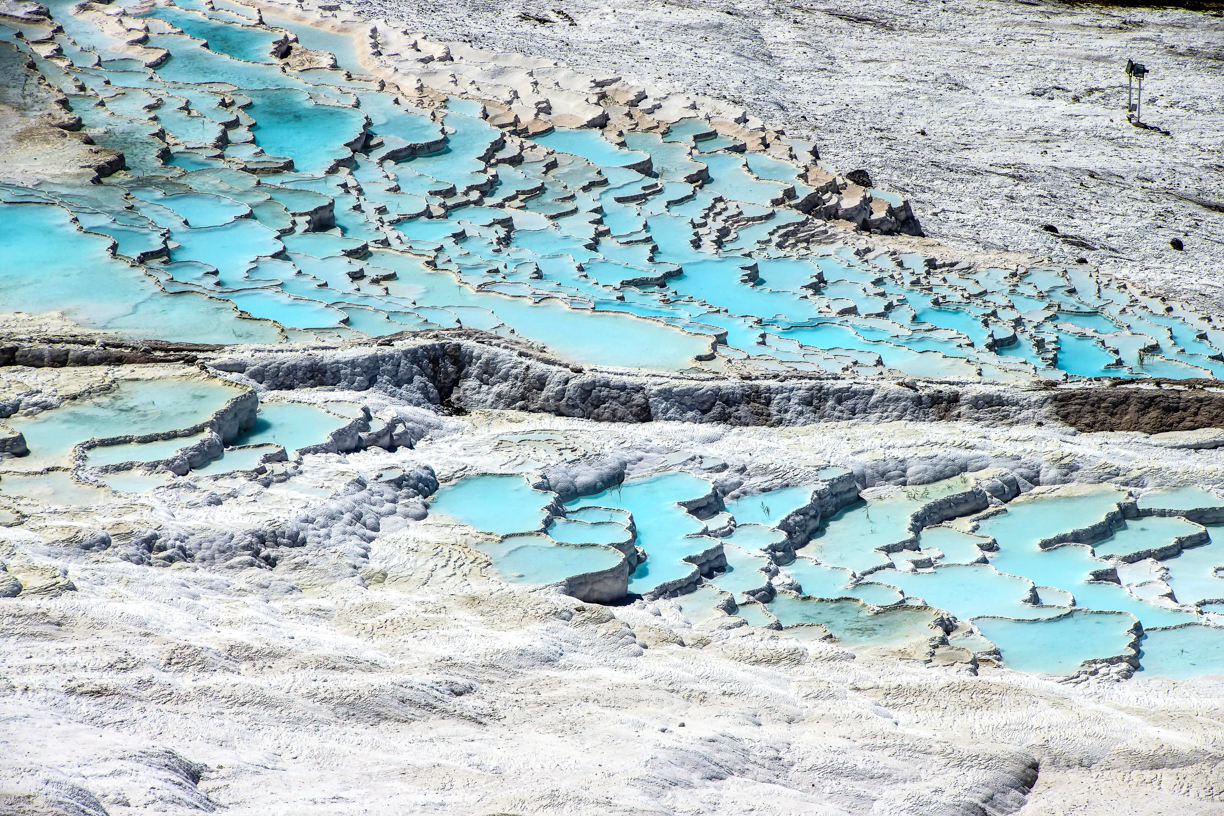Pamukkale, the ‘cotton castle’ in western Turkey, is close to the ancient spa town of Hierapolis. Which was founded by the kings of Pergamum at the end of the 2nd century BCE.
Download royalty-free images of Turkey
The city contains many well-preserved ruins, including a theater and a necropolis stretching for 2km. On our tours, we traverse the original paving to view up-close the sarcophagi and cenotaphs lining both sides. Hierapolis later became an important Christian religious epicenter following the emperor Constantine conversion around 330 CE
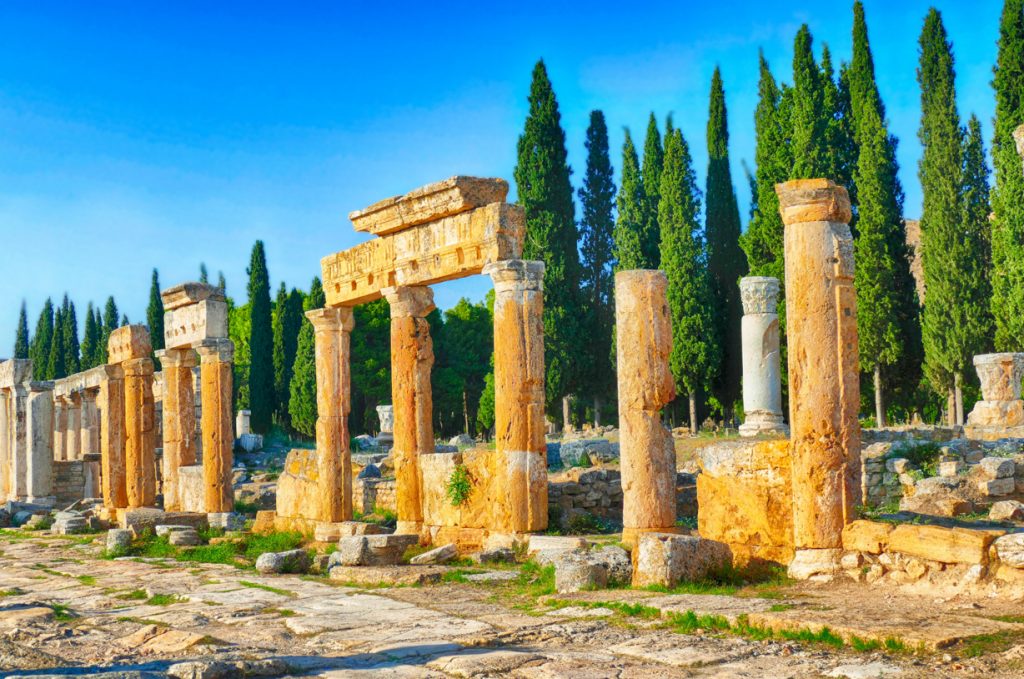
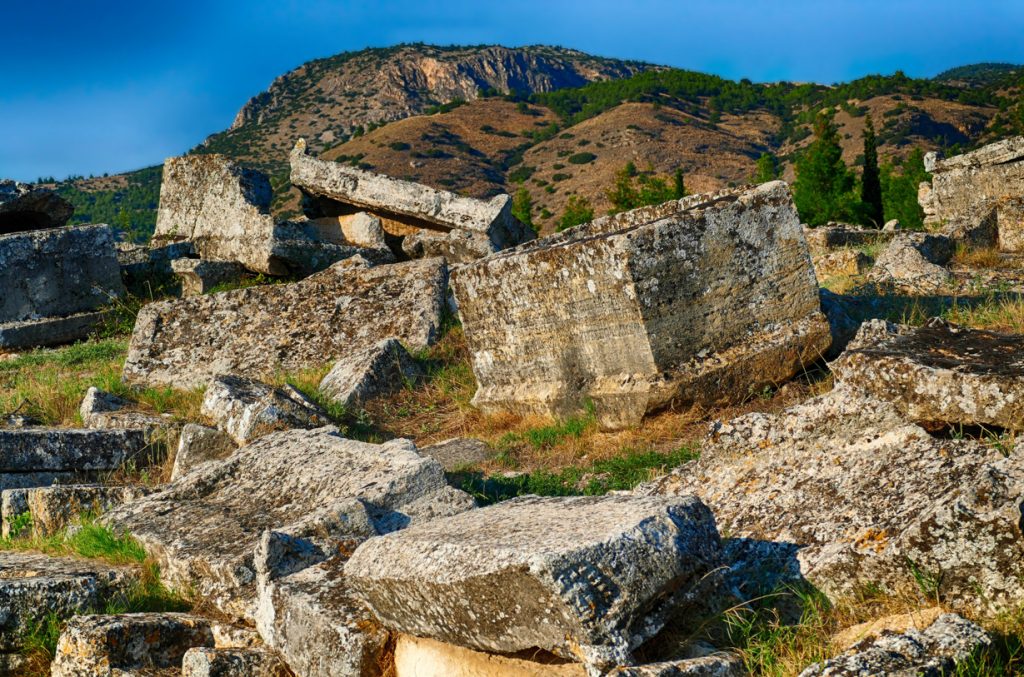
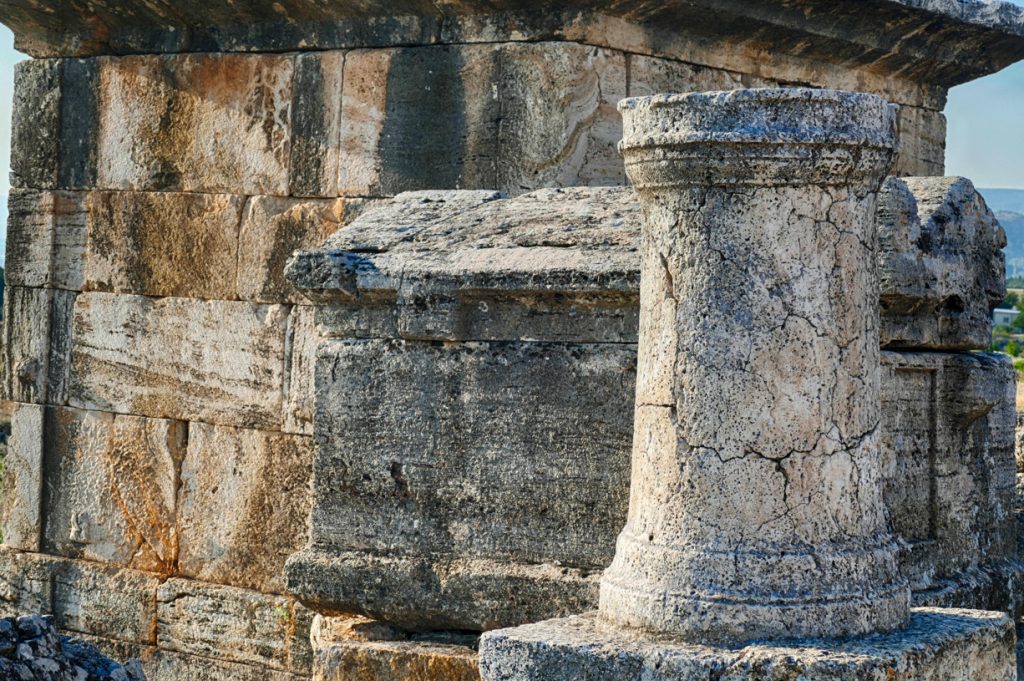
Pamukkale (“paMOOK kalay”) was named for the thermal waters flowing down white travertine terraces on a nearby hillside. Rich in minerals, the terraces formed by this water are a popular tourist attraction. Shoeless, you follow a stream to descend a gentle slope. But bathing in the pools is now prohibited . Overall, access limited to certain paths. This improves the status of the travertine.
The terraces are formed by the flow of calcium-rich hot springs cascading down the mountainside over thousands of years. As the water flows, it leaves behind deposits of calcium carbonate, creating the distinctive white terraces that resemble a frozen waterfall or a cotton-covered hillside.
We first visited over 20 years ago.
The spring water that once fed the travertine terraces had been diverted to supply hotel pools. This led to a decrease in the flow of thermal water. In addition, the travertine was damaged by pollution from sewage. Mechanical damage from tourists, and littering worsened the problems. As a result, the once white terraces turned grey. The decrease in the flow of thermal water and the negative impacts of human activity combined to diminish the beauty of the travertine terraces. Nowhere near the postcard views.

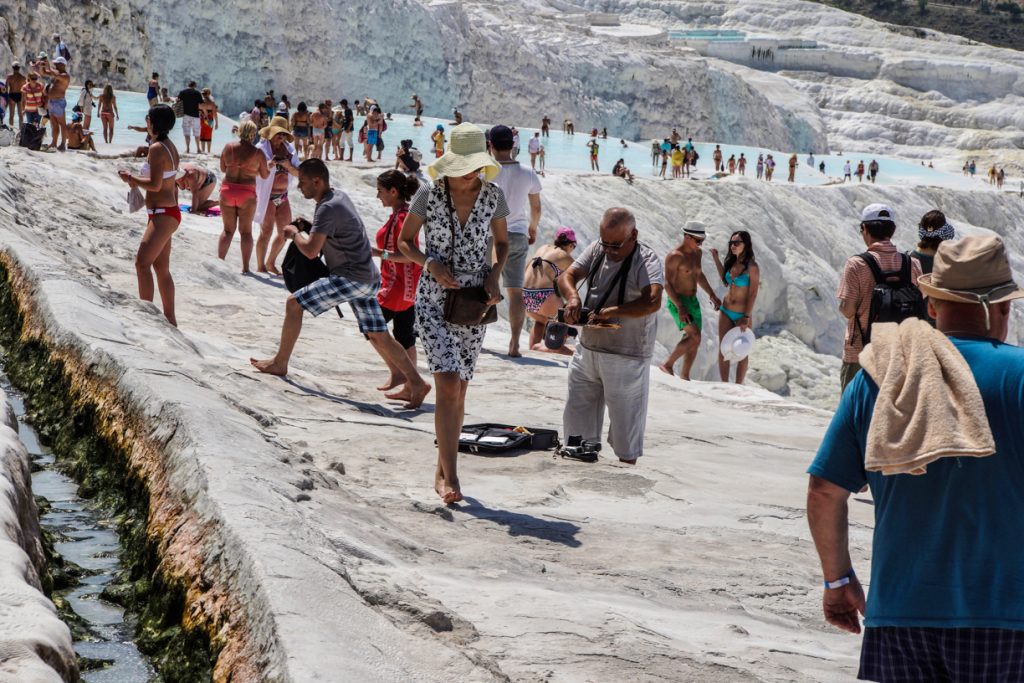
Concerned about the rapid deterioration,
all hotels, pools and shops were removed from the top of the terraces. The Antique Pool (apocryphally visited by Cleopatra) at the visitor center was left; famous for its submerged Roman columns, the aftermath of an earthquake. Over the past 2 decades we watched as the terraces were reconstructed by adding small, ridged dams to let the minerals precipitate and re-form. Most of the terraces are no longer accessible; made necessary by large, daily crowds. They’d carelessly destroy the fragile terraces again.
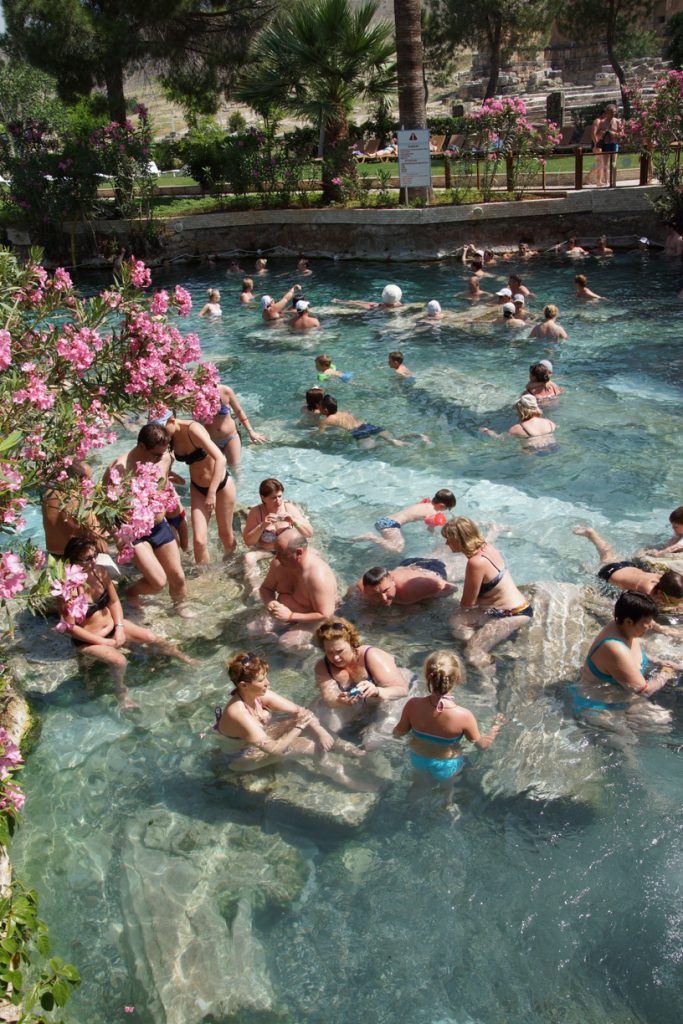

Still, while rating the overall conservation status as “Good with some concerns”
the International Union for Conservation of Nature and Natural Resources has warned that
… high tourist numbers are still an issue which requires careful management for which the current level of staffing is insufficient. There are some concerns about the clarity regarding the responsibilities of different authorities and lack of cooperation between them. There is an urgent need to establish a management unit with representatives from all relevant agencies. There may also be a need to revise the current management plan with integration of social, cultural, economic and natural values at larger landscape level.
From our journal:
With a 9 am start, driving thru cotton fields, eventually reach Sardis, the Lydian capital from 680-547 BCE when captured by the Persians who made it the capital of Asia Minor. Lots of tumuli in surrounding hills, some real, some false to deter grave robbers. Croesus was last king of this rich area. Impressive ruins, large entrance gate, remains of a 3rd c synagogue, Byzantine shops. Lunch in town, Odun Kofte, excellent lamb ground and cooked on skewers, yogurt, grilled whole tomatoes, grilled peppers. Arrive in Pamukkale around 3 or so, time to relax around the pool.
The nearby ancient city of Hierapolis has a long history
Hierapolis: Hierapolis is an ancient city that once thrived in the same region as Pamukkale. The city was founded around the 2nd century BC and became an important Hellenistic and Roman settlement. It was known for its thermal springs, which were used for both bathing and medicinal purposes. Hierapolis was also home to various impressive structures, including a well-preserved theater, temples, a necropolis (cemetery), and an extensive network of streets and houses.
One of the most famous features of Hierapolis is the Plutonium, a cave that was believed to be an entrance to the Underworld due to the deadly carbon dioxide emissions from the ground. Additionally, the city was a center for early Christianity and is said to have been visited by St. Philip the Apostle.
Together, Pamukkale and Hierapolis offer a unique blend of natural beauty and historical significance, making them a popular tourist destination in Turkey. Visitors can explore the ancient ruins of Hierapolis while also enjoying the therapeutic waters of Pamukkale’s terraces. The site is recognized as a UNESCO World Heritage Site due to its cultural and natural value.
Foundation and Hellenistic Period (circa 2nd century BCE): Hierapolis was founded by the Attalid kings of Pergamum around the 2nd century BCE. It was established as a spa city due to its proximity to natural hot springs with therapeutic properties. The city’s name is derived from the Greek words “hieros,” meaning sacred, and “polis,” meaning city.
Roman Period (1st century BCE – 4th century CE): Hierapolis grew in prominence during the Roman era. The city became a popular destination for those seeking the healing benefits of its thermal springs, which led to the construction of various bathhouses, temples, and other structures. The city’s wealth also allowed for the construction of impressive public buildings and theaters.
Christianity and the Martyrdom of Saint Philip: Hierapolis is closely associated with early Christianity. According to tradition, the apostle Philip (one of the Twelve Apostles) was martyred in Hierapolis during the 1st century CE. The city became an important Christian center, and its Christian community left its mark through the construction of churches and other religious buildings.
Byzantine Period (4th century – 7th century CE): Hierapolis continued to thrive under Byzantine rule, and it remained an important center for Christianity in the region. The city’s religious significance led to the construction of more churches and religious structures.
Decline and Abandonment: The city began to decline due to a combination of factors, including earthquakes, changes in trade routes, and shifts in political power. By the 7th century CE, the city had been largely abandoned, and its once-great structures fell into disrepair.
Rediscovery and Archaeological Excavations: The ancient ruins of Hierapolis were rediscovered in the 19th century. Archaeological excavations have been ongoing, revealing the city’s well-preserved theater, necropolis (cemetery), thermal baths, and other structures. The site was designated a UNESCO World Heritage Site in 1988, along with the nearby ancient city of Pamukkale, which is known for its unique white terraces formed by mineral-rich hot springs.
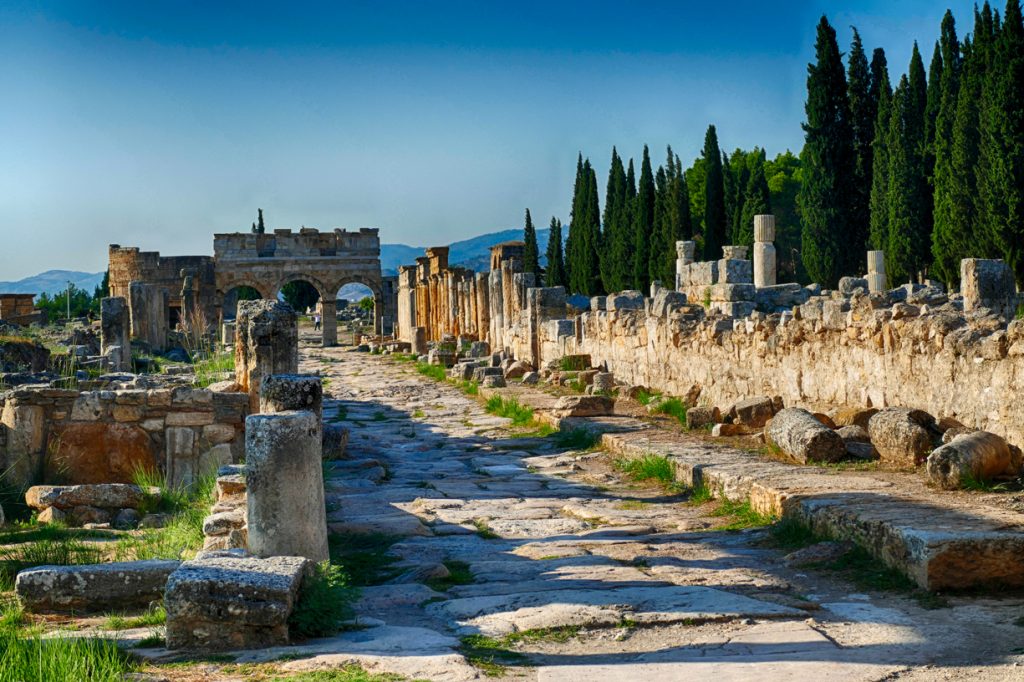
Today, visitors to Hierapolis can explore its extensive ruins, including the well-preserved theater, Roman bathhouses, temples, and the Martyrium of Saint Philip. The site offers a glimpse into the city’s past and the various civilizations that once called Hierapolis home. We usually walk along the 2 km main colonnaded street with ancient homes, shrines, cenotaphs and tombs.
